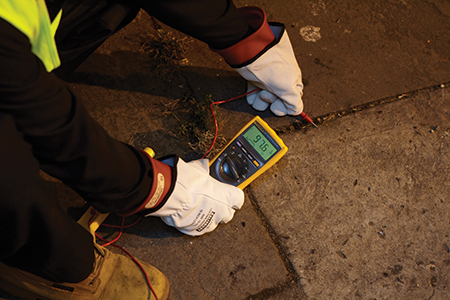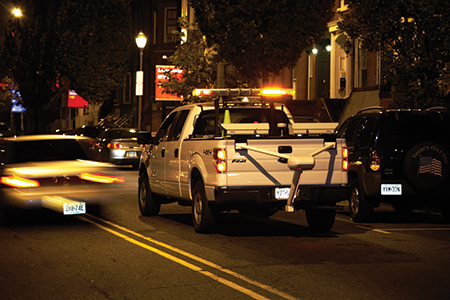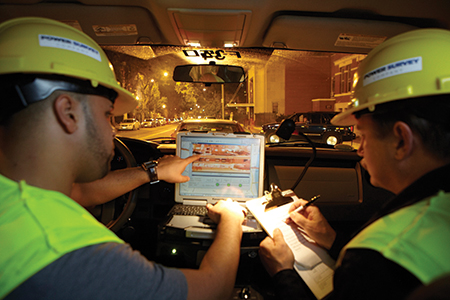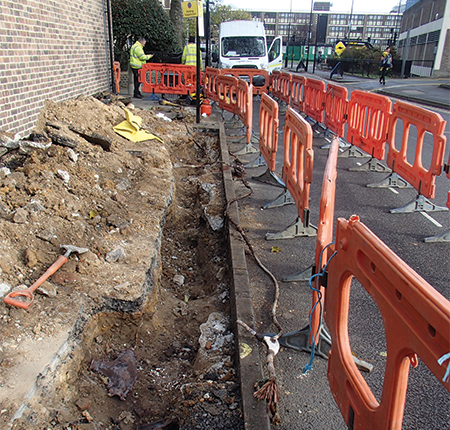UK Power Networks (UKPN) is on a mission to reduce system losses and is considering some unconventional means. Conventional wisdom is that electric distribution system losses are primarily from two sources; resistive losses and transformer excitation losses. Of course a lot of that conventional wisdom is confirmed by the detailed abilities to monitor and measure power flows on medium and high voltage systems. But UKPN considered another source of losses, leakage on the low voltage distribution system. Ultimately, all distribution systems leak, and some leakages are easier to detect than others. For example when a water distribution system leaks flooding in the street often makes the location of the problem apparent, when natural gas distribution systems leak the odorant in the gas alerts the public to the potential leak; but what about when an electric distribution system leaks, there is no odor or visual indication of the leak.
UKPN recognized that their more than 19,000 km of low voltage distribution cables could result in measurable losses, but was uncertain of how best to pinpoint those leaks. Consider that the low voltage cable is expected to provide decades of reliable service with little attention and certainly with little monitoring. In fact the only alert that something may be amiss comes from customer outages, the result of a defect.
When the insulation system on low voltage secondary cable fails, conductive pathways are formed from the conductors to the earth. Quite often these leaks are high impedance faults. These faults draw relatively small amounts of current compared to the load on the cables; as a result fuses and cable limiters do not operate and thereby eliminate the fault. Because protective systems do not exist to detect and interrupt the current from these failures they can persist for very long periods of time. And the robust nature of the low voltage conductors allows them to continuously supply current directly into the earth.

One significant characteristic of these faults is that they can energize street level objects, a condition known as contact voltage. The voltages measured at the surface can range from just a few hundred millivolts to full line voltage. The energized objects can present a public safety hazard under certain conditions but, the energized objects are also key to finding the leaks that feed them. Anytime a street level object becomes energized, it emits an electric field signature that can be detected in the local vicinity.
In search of a method to uncover these leaks, in early 2015 UKPN partnered with Power Survey Company, a provider of contact voltage testing services, to explore possible solutions to this interesting problem. Power Survey uses extremely sensitive electric field measuring equipment integrated into their fleet of mobile contact voltage detectors, known as the SVD-2000, to identify contact voltage conditions. Essentially a tailor made solution to the problem of finding leaks from the low voltage distribution system.

Utilities traditionally employ mobile contact voltage detection to optimize low voltage asset management programs by identifying incipient faults and to address the safety concerns associated with energized street level objects. After rethinking these faults as leaks it became clear that the faults normally identified during mobile contact voltage surveys were also the source of significant losses. Although Power Survey has identified more than 120,000 contact voltage faults for clients around the world, no one had ever attempted to quantify the losses associated with these faults.

To prove the concept, a pilot scan was initiated in areas of UKPN’s low voltage network. During the survey technicians traversed the streets in the SVD-2000 searching for instances of voltages on street level objects such as sidewalks, street lamps and bus shelters. When voltage is detected by the SVD-2000 audible and visual alarms alert the operators to the presence of an electric field anomaly. To pinpoint the fault location the technicians follow a formalized site assessment process outside of the vehicle.
There are number of steps along the path from detection to measurement and mitigation. The first step to identify an underground cable failure starts with localization of the area where the offending cable may be located. When the truck mounted detection equipment signals an alarm, technicians exit the vehicle equipped with a very sensitive hand held electric field detector to center the investigation on a point where local electric field signature peaks. The next step is to measure the voltage on the objects and surfaces identified in the previous step. This requires a volt meter with a shunt resistor and some additional effort to identify a qualified ground reference point.
A qualified ground is typically a nearby metallic object such as a fire hydrant, stand pipe, or other earth connected conductive structure. Steps to qualify that ground include using the hand held electric field meter to verify the candidate ground is in fact not energized. When this is complete, a voltage measurement is made on all of the surfaces and structures above and around the suspected leak. Finally a record of the voltage is created.
Low voltage readings, often below one volt, when found in the vicinity of buried service or distribution conductors are a key indicator. The analysis of the facts at hand is the path to finding the offending cable. Referencing system schematics and maps can be helpful, but often records are incomplete. In fact, some observation skills and experience with the local system are often very beneficial.
Finding the actual leak requires careful excavation and repeated voltage measurement as excavation proceeds. If the process has successfully identified a buried leak, then by definition there is a live conductor nearby and all of the safety and precautionary measures associated with excavation will be required. Since we are interested in quantifying the leaks, it is important when possible to measure current on the conductors nearby before excavation commences. Current measurements taken before and after repairs will be useful in gauging how much current was leaking into the earth.
Proving the concept started with performing a pilot scan in the distribution territory. Using the scan data, several sites were selected for further investigation and measurement. Sites were selected primarily based on the ease of excavation and the proximity of the fault to UKPN’s LV network, based on a review of system schematics and GIS data. A team of engineers, technicians and scientists unearthed the failures responsible for the power leaks, made current measurements and collected data on the underlying fault conditions, the results surprised everyone.
Prior to actually finding the leaks and performing measurements, some estimates of the possible outcomes were made. Initial theoretical models of the average impedance of the earth were around 120 Ω, and using the system supply voltage as a source, we calculated losses of approximately 437 watts per fault or about 3.8 MWh/year. But with the benefit of measurements made in the field, we found the actual earth impedances were much lower, often between 20 Ω and 45 Ω, lower than many standards for earthing rod installations. At one site a failed joint had formed a conductive pathway to the earth and was continuously leaking over 10 amps into the ground.

The benefit in repairing these types of leaks can be significant. Annual losses at the location sourcing 10 amps into the earth were 21 MWh/year. The carbon dioxide emissions associated with the energy losses are approximately 12.8 tonnes. To put the emissions into perspective, according to the World Bank, the average UK citizen is responsible for approximately 7 tonnes of carbon dioxide per year by addressing a single leak UKPN was able to offset the emissions of nearly two citizens.
Forensic analysis of the excavated cables provided some additional interesting facts. The fault and associated current flow can generate significant heating of the cabling. It was apparent the heat flowed from the fault along the conductor and further damaged insulation. A section of cable 25 meters in length was excavated. The photo on the previous page shows the extent of the damage. Insulation is cracked and eroding and the protective steel cable sheath has disappeared. The service life of this length of cable has been ended by the long term heating provided by the fault current.
The pilot scan clearly demonstrated that the SVD-2000 is effective at identifying sites where low voltage cables are leaking voltage into the surrounding environment. In every case where voltage was measured on the surface and a site investigation was conducted the source of the voltage was determined to be a leaking low voltage underground cable. The ability to quickly and accurately locate these electric system leaks represents a paradigm shift in low voltage cable loss strategies.
Whilst conventional losses strategies focus on the tricky and costly practice of reducing resistive losses in conductors and optimizing transformer designs and ratings; this innovative strategy is centered around addressing leaks in low voltage cables. Repairing these leaks in a targeted manner not only reduces losses and system load, it also enhances the customer experience by improving grid resiliency and minimizing power quality concerns by efficiently removing failing sections of cable from the system.
About the Author
 Jeremy Wright BEng (Hons) MBA (Open) MIET MIAM MCIM is an award winning Electrical Engineer who works for UK Power Networks (UKPN) in London and is a member of both The Institute of Engineering and Technology (The IET) and The Institute of Asset Management (The IAM). He has a passion for continued innovation within the electricity distribution network in the UK and has achieved recognition for his work both as an individual and from leading a team by both The IET and The IAM.
Jeremy Wright BEng (Hons) MBA (Open) MIET MIAM MCIM is an award winning Electrical Engineer who works for UK Power Networks (UKPN) in London and is a member of both The Institute of Engineering and Technology (The IET) and The Institute of Asset Management (The IAM). He has a passion for continued innovation within the electricity distribution network in the UK and has achieved recognition for his work both as an individual and from leading a team by both The IET and The IAM.
Since 1984 Jeremy has undertaken a number of senior operational and non-operational roles. His current role is to ensure that assets installed on the UKPN electricity distribution networks are operated and compliant with current policy and procedures often engaging with stakeholders and regulatory bodies.
The latest project Jeremy is pioneering within the UK is with Power Survey Corp. and the SVD-2000 contact voltage Mobile Asset Assessment Vehicle (MAAV). This platform has the potential to revolutionise how cables are managed and replaced ahead of failure which is not currently considered by network operators. This is one of many revolutionary systems that Jeremy is or has pioneered in his career to the benefit of both customers and network operators.







